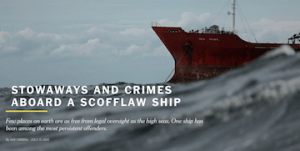Stowaways and crimes aboard a scofflaw ship
 Selase Kove-Seyram is a Ghanaian freelance journalist and documentary maker. He worked on this story with Ian Urbina of the New York Times. As a partner media ghanabusinessnews.com is sharing this in-depth investigative work on the high seas with you.
Selase Kove-Seyram is a Ghanaian freelance journalist and documentary maker. He worked on this story with Ian Urbina of the New York Times. As a partner media ghanabusinessnews.com is sharing this in-depth investigative work on the high seas with you.
“Standing on the deck of a 400-foot ship, hundreds of miles from the West African coast in the South Atlantic Ocean, I looked over at Ian Urbina, the reporter I had joined on this assignment. He smiled at me and said, “Game day.” I knew exactly what he meant.
For most journalists who report on the environment, land is their playing field. Rarely, do they venture offshore. I therefore jumped at the opportunity to work as a photographer alongside Ian, who has been an investigative reporter with the Times for over a decade covering everything from arms dealers, runaways, the oil and gas industry and workers rights.
For me, this was a new terrain. As a topic, it was bigger. It had global implications. I joined Ian at the tail end of his project that took him a year and a half to report and that spanned ten countries and took him far out at sea, including on some very dangerous ships. The New York Times had invested unprecedented resources into the project which focuses on lawlessness on the world’s oceans. With depth and journalistic rigor, the stories touch on a wide range of human rights, environmental and labor crimes that occur with impunity.
While the Times’ project dives deep into this sprawling and complicated subject, the coverage should carry distinct resonance for the African continent. Few places in the world have more interest in the sea than Africa. Annually, Africa loses over $1 billion because foreign vessels poach fish from national waters. Fishing is one of the continent’s major sources of revenue, with more than 12 million African fishermen. Piracy and other forms of maritime violence remains a major financial drain and source of instability. Poverty and war cause tens of thousands of people each year to flee Africa, sneaking onto ships as stowaways or brokered by human traffickers — and their fates at sea is often brutal and deadly.
Take a look. The first installment of this four-part series is published here.”
